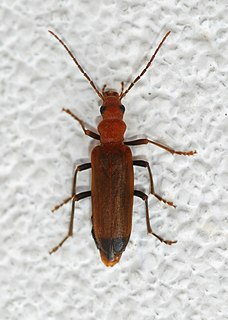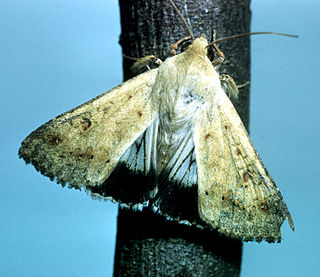
Helicoverpa zea, commonly known as the corn earworm, is a species in the family Noctuidae. The larva of the moth Helicoverpa zea is a major agricultural pest. Since it is polyphagous during the larval stage, the species has been given many different common names, including the cotton bollworm and the tomato fruitworm. It also consumes a wide variety of other crops.

The Tortricidae are a family of moths, commonly known as tortrix moths or leafroller moths, in the order Lepidoptera. This large family has over 11,000 species described, and is the sole member of the superfamily Tortricoidea, although the genus Heliocosma is sometimes placed within this superfamily. Many of these are economically important pests. Olethreutidae is a junior synonym. The typical resting posture is with the wings folded back, producing a rather rounded profile.

Dermestidae are a family of Coleoptera that are commonly referred to as skin beetles. Other common names include larder beetle, hide or leather beetles, carpet beetles, and khapra beetles. There are approximately 500 to 700 species worldwide. They can range in size from 1 to 12 mm. Key characteristics for adults are round oval shaped bodies covered in scales or setae. The usually clubbed antennae fit into deep grooves. The hind femora also fit into recesses of the coxa. Larvae are scarabaeiform and also have setae.

Polygonia interrogationis, commonly called the question mark butterfly, is a North American nymphalid butterfly. It lives in wooded areas, city parks, generally in areas with a combination of trees and open space. The color and textured appearance of the underside of its wings combine to provide camouflage that resembles a dead leaf. The adult butterfly has a wingspan of 4.5–7.6 cm (1.8–3.0 in). Its flight period is from May to September. "The silver mark on the underside of the hindwing is broken into two parts, a curved line and a dot, creating a ?-shaped mark that gives the species its common name."

Choristoneura fumiferana, the eastern spruce budworm, is a species of moth of the family Tortricidae native to the eastern United States and Canada. The caterpillars feed on the needles of spruce and fir trees. Eastern spruce budworm populations can experience significant oscillations, with large outbreaks sometimes resulting in wide scale tree mortality. The first recorded outbreaks of the spruce budworm in the United States occurred in about 1807, and since 1909 there have been waves of budworm outbreaks throughout the eastern United States and Canada. In Canada, the major outbreaks occurred in periods circa 1910–20, c. 1940–50, and c. 1970–80, each of which impacted millions of hectares of forest. Longer-term tree-ring studies suggest that spruce budworm outbreaks have been recurring approximately every three decades since the 16th century, and paleoecological studies suggest the spruce budworm has been breaking out in eastern North America for thousands of years.

Rhagoletis mendax is a species of tephritid fruit fly known by the common name blueberry maggot. The blueberry maggot is closely related to the apple maggot, a larger fruit fly in the same genus. It is a major pest of plant species in the Ericaceae family, such as blueberry, cranberry, and huckleberry. The larva is 5 to 8 mm long, apodous, and white with chewing mouthparts. Female adults are 4.75mm in length, males are slightly smaller. Both adults are mostly black in color with white stripes, orange-red eyes, and a single pair of clear wings with black banding. The adult female fly lays a single egg per blueberry, and when the larva hatches it consumes the fruit, usually finishing the entire berry in under 3 weeks and rendering it unmarketable. The larva then falls to the soil and pupates. Adult flies emerge, mate, and females oviposit when blueberry plants are producing fruit. Each female fly can lay 25 to 100 eggs in their lifetime.

The wharf borer, Nacerdes melanura, belongs to the insect order Coleoptera, the beetles. They belong to the family Oedemeridae, which are commonly known as false blister beetles. Wharf borers are present in all the states of the USA except for Florida. It takes about a year to develop from an egg to an adult. The insect is called the 'wharf borer' because the larval stage of this insect is often found on pilings and timbers of wharves, especially along coastal areas. The adult beetles can be identified via a black band across the end of both elytra, or wing covers. In addition, wharf borers can be distinguished from other members of the family Oedemeridae via the presence of a single spur on the tibia of the forelegs, and the distance between both eyes. Eggs are oviposited on rotten wood where larvae hatch and burrow to feed on rotten wood. Adults do not feed and depend on stored energy reserves accumulated during the larval stage. They are considered to be a pest because they damage wood used in building infrastructures.

Galleria mellonella, the greater wax moth or honeycomb moth, is a moth of the family Pyralidae. G. mellonella is found throughout the world. It is one of two species of wax moths, with the other being the lesser wax moth. G. mellonella eggs are laid in the spring, and they have four life stages. Males are able to generate ultrasonic sound pulses, which, along with pheromones, are used in mating. The larvae of G. mellonella are also often used as a model organism in research.

Helicoverpa punctigera, the native budworm, Australian bollworm or Chloridea marmada, is a species of moth in the family Noctuidae. This species is native to Australia. H. punctigera are capable of long distance migration from their inland Australian habitat towards coastal regions and are an occasional migrant to New Zealand.

Chloridea virescens, commonly known as the tobacco budworm, is a moth of the family Noctuidae found throughout the eastern and southwestern United States along with parts of Central America and South America.

Cnaphalocrocis medinalis, the rice leafroller, is a species of moth of the family Crambidae. It is found in south-east Asia, including Hong Kong, Sri Lanka, Taiwan, Thailand and most of Australia.

Helicoverpa assulta, the oriental tobacco budworm, is a moth of the family Noctuidae. H. assulta adults are migratory and are found all over the Old World Tropics including Asia, Africa, and Australia.
Glyphodes perelegans is a moth of the family Crambidae described by George Hampson in 1898. It is native to South America, where it is found in the Andes Mountains of Venezuela, Colombia, and Ecuador. It has been introduced to Hawaii to control banana poka.

Lymantria dispar dispar or LDD moth, commonly known as the gypsy moth, European gypsy moth, North American gypsy moth, or spongy moth, is a species of moth in the family Erebidae that is of Eurasian origin. It has a range that extends over Europe, Africa, and North America.

Choristoneura freemani, the western spruce budworm, is a species of moth of the family Tortricidae. It is the most destructive defoliator of coniferous forests in western North America.

A gnat is any of many species of tiny flying insects in the dipterid suborder Nematocera, especially those in the families Mycetophilidae, Anisopodidae and Sciaridae. They can be both biting and non-biting. Most often they fly in large numbers, called clouds. "Gnat" is a loose descriptive category rather than a phylogenetic or other technical term, so there is no scientific consensus on what constitutes a gnat. Some entomologists consider only non-biting flies to be gnats. Certain universities and institutes also distinguish eye gnats: the Smithsonian Institution describes them as "non-biting flies, no bigger than a few grains of salt, ... attracted to fluids secreted by your eyes".

Apion apricans is a species of seed weevils native to Europe. It is widespread everywhere. Damages clover and wild. The beetle is 3–3.5 mm in size, black, with a metallic hue, the body is pear-shaped, the legs are partially yellow; rostrum long, almost straight; apex of antennae black, base - red. Egg - 0.3-0.5 mm, yellowish, long, smooth. Larva 2–2.5 mm, white with a creamy hue, curved, dark brown head, on the upper jaws on each side of three growths, the middle of them increased; instead of legs six pairs of small knolls. Pupa 3–3.5 mm, yellowish white.

Eurybia elvina, commonly known as the blind eurybia, is a Neotropical metalmark butterfly. Like many other riodinids, the caterpillars are myrmecophilous and have tentacle nectary organs that exude a fluid similar to that produced by the host plant Calathea ovandensis. This mutualistic relationship allows ants to harvest the exudate, and in return provide protection in the form of soil shelters for larvae. The larvae communicate with the ants by vibrations produced by the movement of its head. The species was described and given its binomial name by the German lepidopterist Hans Stichel in 1910.

Diparopsis castanea is the type species of the genus Diparopsis: moths in the family Noctuidae; no subspecies are listed in the Catalogue of Life. This is known as the red bollworm, which is a significant pest of cotton crops in Eastern and Central-Southern Africa.

Odoiporus longicollis, commonly known as banana stem weevil or banana pseudostem borer, is a species of weevil found in South Asia and South East Asia.


















